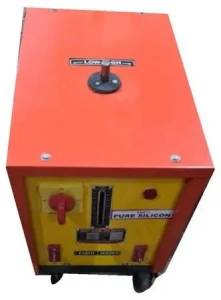Description
REGULATOR TYPE ARC WELDING: Precise Control for Superior Welds
This comprehensive guide details Regulator Type Arc Welding, a precise and versatile welding process ideal for a range of applications requiring controlled heat input and consistent weld quality. Unlike simpler arc welding methods, Regulator Type Arc Welding offers superior control over the arc, leading to cleaner, stronger, and more aesthetically pleasing welds.
Understanding Regulator Type Arc Welding:
Regulator Type Arc Welding leverages a specialized regulator to precisely control the welding current. This fine-tuned control allows the welder to manipulate the arc's characteristics – its length, intensity, and heat output – with greater accuracy. This is achieved through a combination of:
- Precise Current Adjustment: The regulator allows for smooth, incremental adjustments to the welding current, enabling the welder to tailor the arc to the specific material and thickness being welded. This eliminates the guesswork inherent in simpler methods, resulting in more consistent weld penetration and bead formation.
- Improved Arc Stability: The regulator helps maintain a stable arc even with fluctuating power supplies or changes in the welding position. This minimizes arc interruptions and ensures a more consistent weld bead.
- Enhanced Control of Heat Input: Accurate control over current translates to precise control over heat input. This allows for welding thinner materials without burn-through and thicker materials without excessive heat buildup and distortion.
Applications:
Regulator Type Arc Welding finds its place in various applications where precise control and consistent weld quality are paramount, including:
- Sheet Metal Fabrication: Ideal for welding thin gauge metals without burn-through.
- Automotive Repair: Provides the precision needed for clean and structurally sound repairs.
- Manufacturing: Suitable for intricate welding tasks in various industries.
- Maintenance and Repair: Useful for repairing critical components requiring a high level of precision.
Advantages over Conventional Arc Welding:
- Increased Precision: Significantly improved control over arc characteristics leads to more accurate and consistent welds.
- Reduced Weld Defects: Minimizes the risk of porosity, undercutting, and spatter.
- Improved Weld Quality: Results in stronger, cleaner, and more aesthetically pleasing welds.
- Enhanced Efficiency: Precise control reduces rework and increases overall welding efficiency.
- Versatility: Suitable for a wider range of materials and thicknesses.
Considerations:
- Initial Investment: The specialized regulator may represent a higher initial investment compared to basic arc welding equipment.
- Skill Requirement: While not excessively complex, operator skill and understanding of the regulator's functions are important for optimal results.
Conclusion:
Regulator Type Arc Welding represents a significant advancement in arc welding technology, offering superior control, consistency, and weld quality. While requiring a slightly higher initial investment and operator training, the benefits in terms of precision, efficiency, and improved weld quality far outweigh the costs for applications where accuracy and consistency are critical. This method is a valuable asset for professionals seeking to elevate their welding capabilities and deliver consistently high-quality results.
